Co-insurance
BRIEF: Design a way for people to manage complex risk together.
Team Member: Ruoxi Song, Qibin Cheng, Wan Ying, Harry Solomons
TimeFrame: 02 FEB.-09 MAR.
Team Member: Ruoxi Song, Qibin Cheng, Wan Ying, Harry Solomons
TimeFrame: 02 FEB.-09 MAR.
To begin this brief, we were unsure of where to start or what topics to cover due to its broad nature and less specific requests or concepts from our partner, AXA. Therefore, we conducted research on several topics that we found interesting and relevant to this brief. We divided our team of eight into four groups, each tasked with researching a specific topic.
Topic Research:
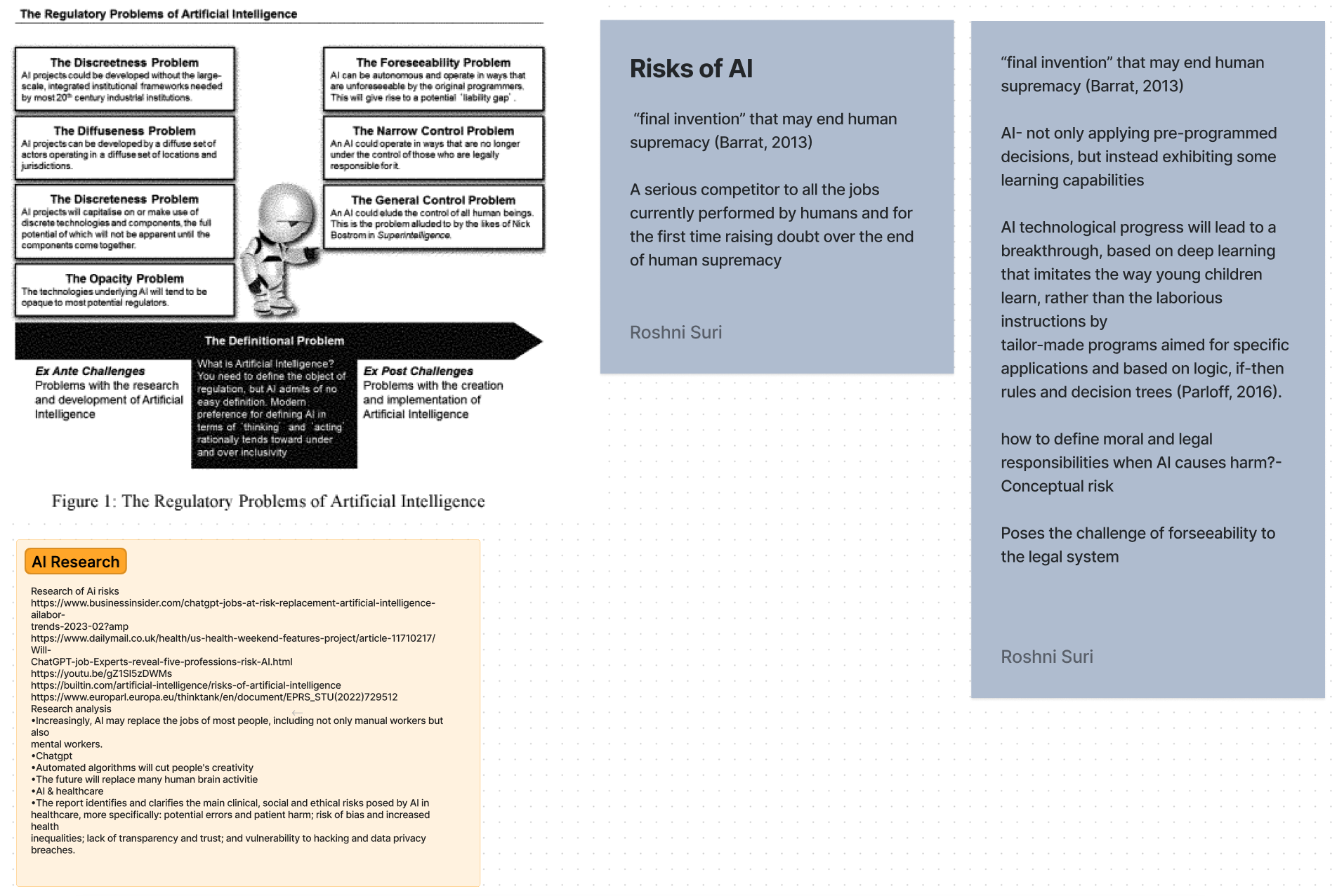
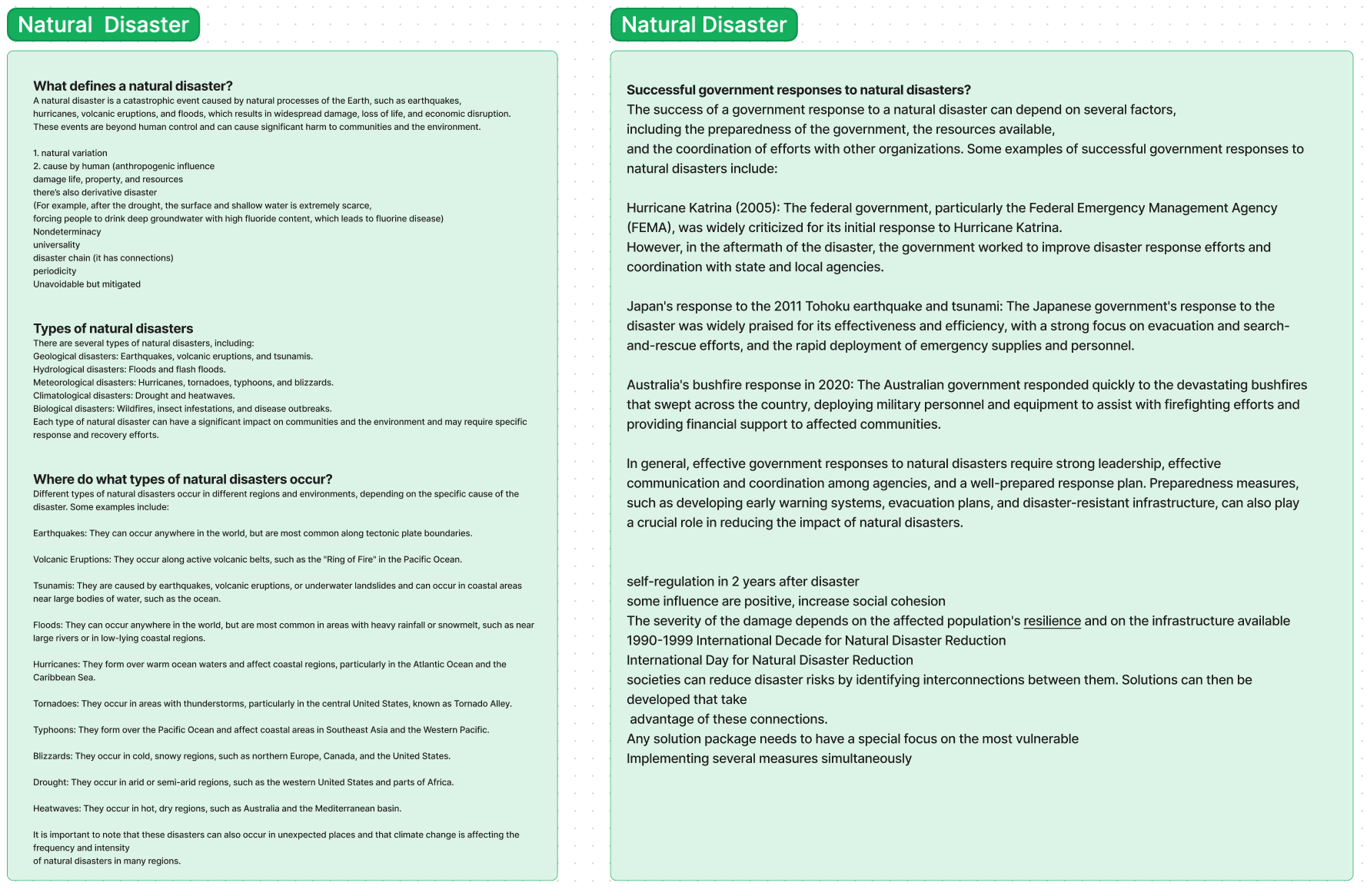


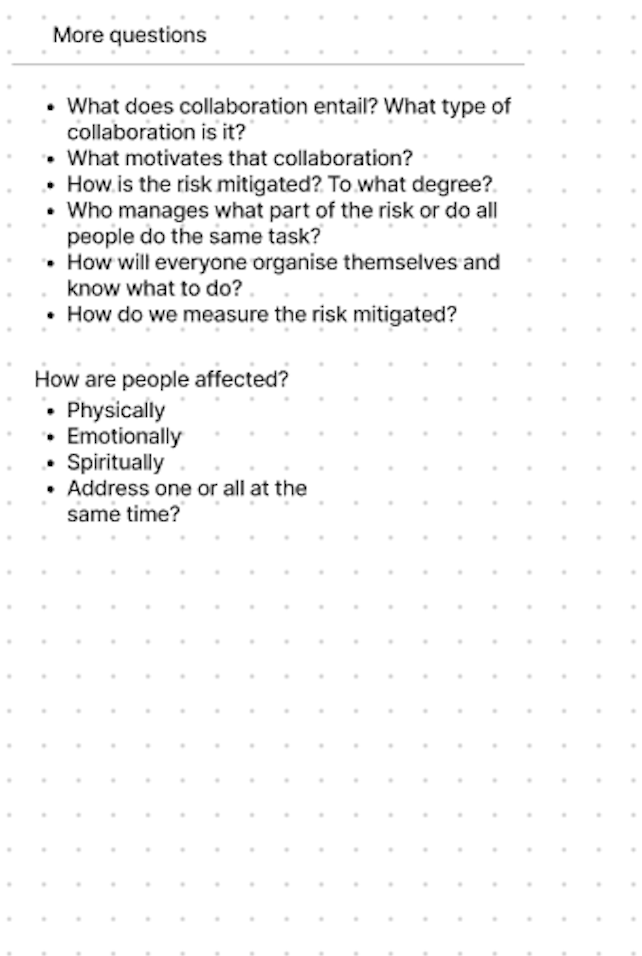



Analysis:
We have discovered that AI can be useful in many areas, including natural disaster response, healthcare, and education. Therefore, we would like to focus on exploring how AI can be integrated into other fields and identifying the potential risks involved. So our next research would be associated risks of AI, and what kind of communities or strategies can we define within the risks.
In the meantime, we also trying to dividing ourselves into two group based on the skills of each of us in a teamwork setting, and our focuses of topics and interests.
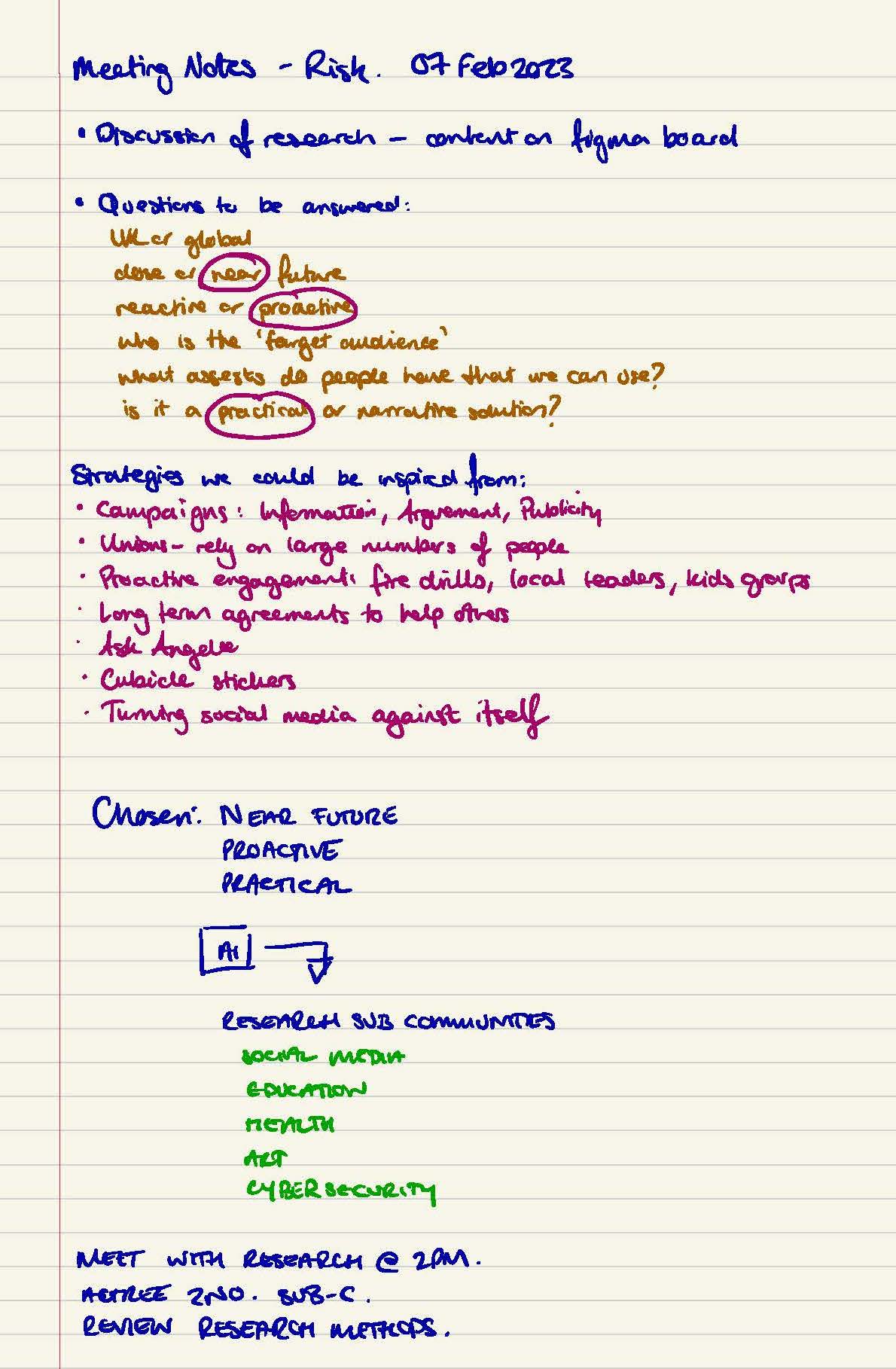
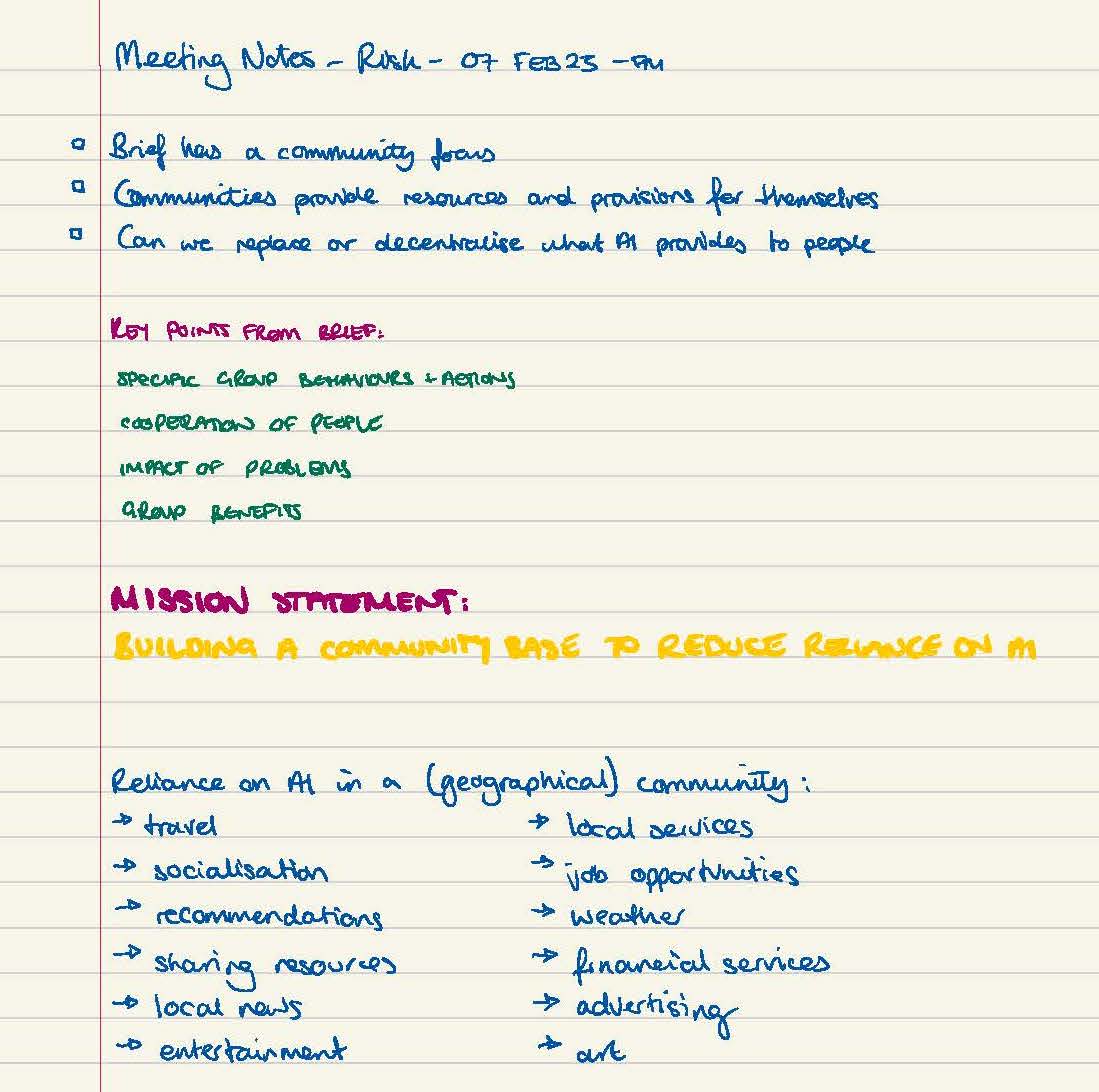

From the tutorials, we are suggested to do literature/practices review about risks in AI, design examples, looked at weaponized design, and speculative design. We also need to think about what research methods we can use for our project. Our topic is still too board now, we need to find a specific risk/situation and also a specific community.
Research on AI:




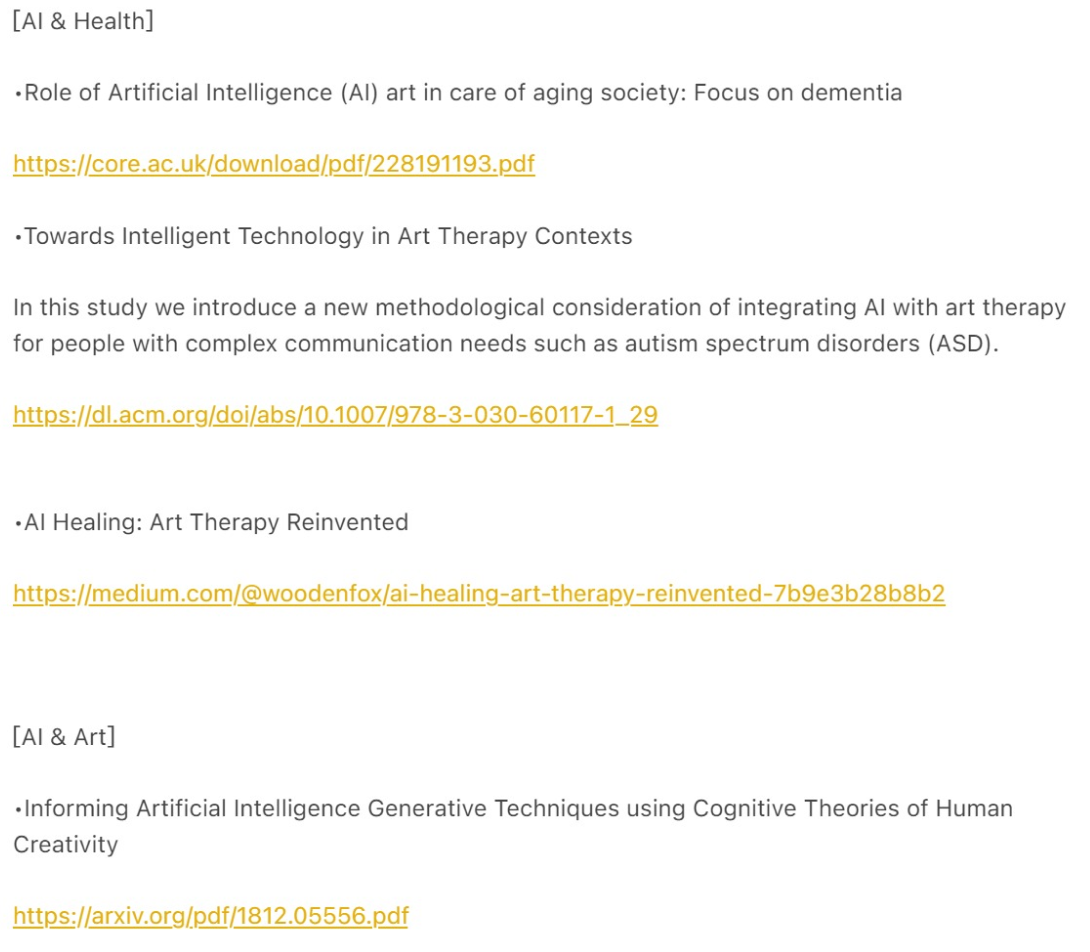
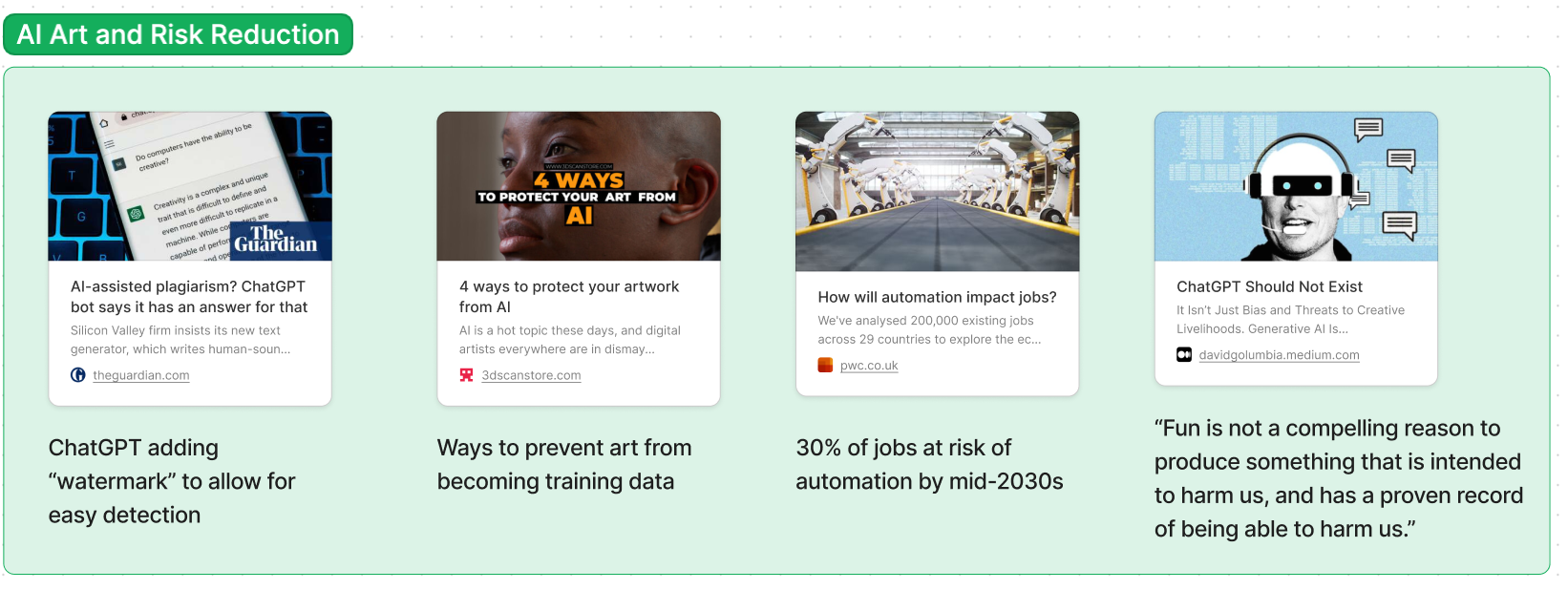

Research Analysis and Synthesis:
We combined the risks we found on AI with communities and strategies, so it can help us connect our ideas together and find a clear and specific route we want to go. We had found the risks of over reliance in younger generations, awareness of risks of AI, risks of lack of creativity for artists, and the infringement.
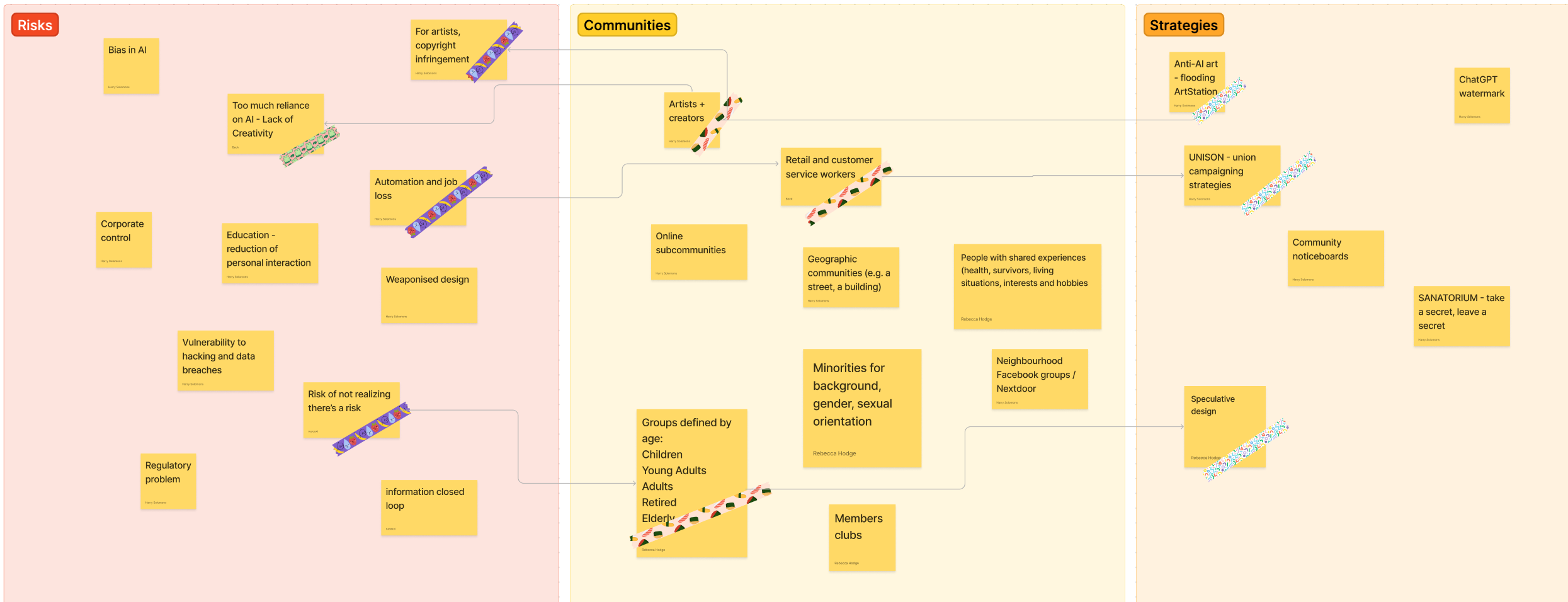
From the synthesis, we found we are mostly interested in two directions, AI art and AI education and the communities are becoming clear as we categorized them. At this time, our group was discussing maybe we can build a community focus on helping people reduce reliance on AI.
However, I don't completely agree that we need to reduce our reliance on AI. Instead, I think we should find a way to work with AI as our partners rather than seeing them as our enemies. Nevertheless, we need to be cautious about how AI affects our independent thinking, self-judgment, and creativity. It's easy to simply accept the answers provided by AI without actually understanding them, especially among younger generations that can easily ask Alexa for math solutions.
First Week Presentation and feedback:

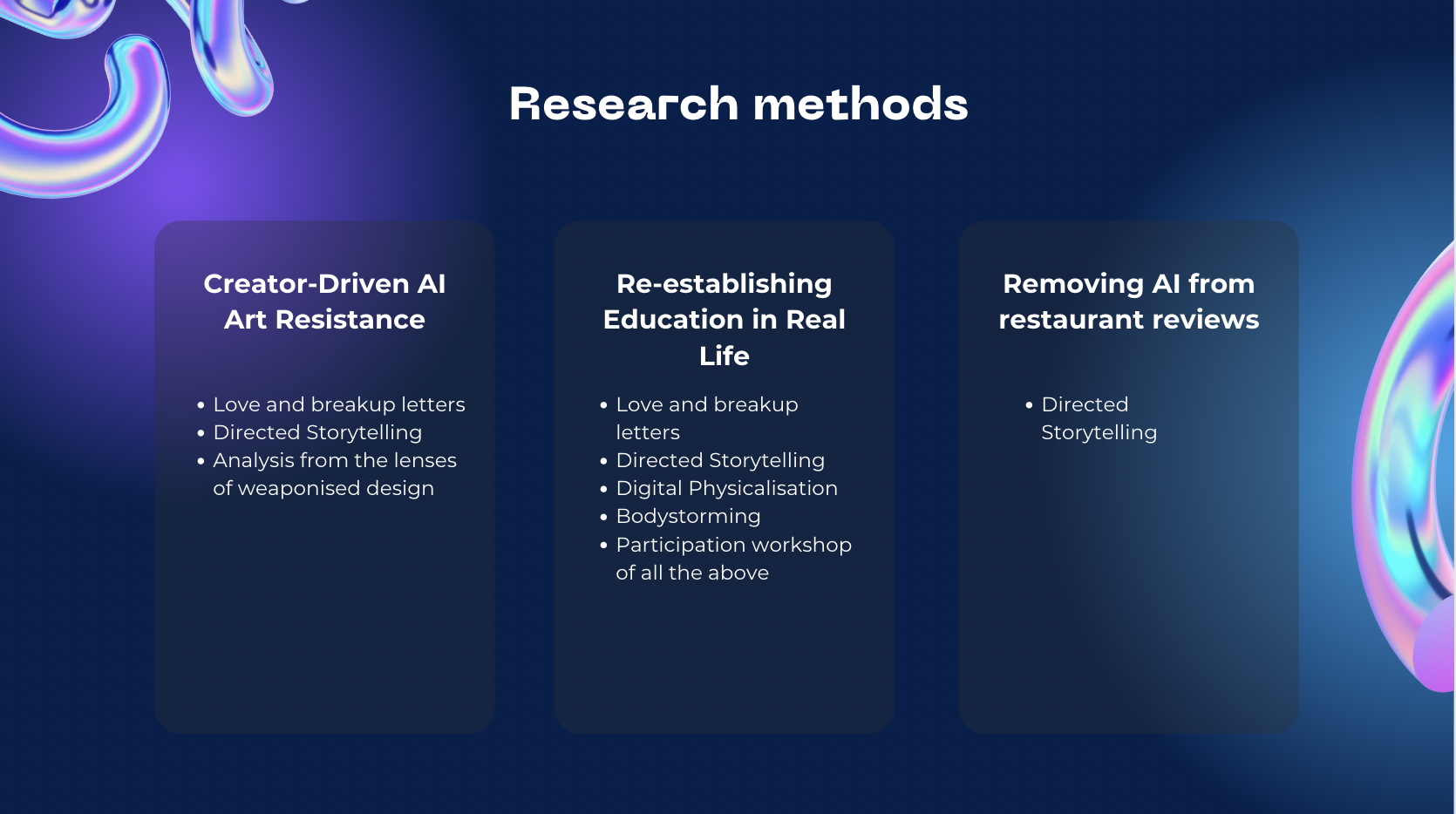
During our presentation, we covered the risks we found from our research on AI in art and AI in education, as well as the potential communities that may be impacted by these risks. While we received positive feedback on our research, we were advised to focus on a specific situation and community. To accomplish this, we can consider using research methods such as collage, body storming, and scenario building. Additionally, we need to consider the tangible forms of AI.
Another reminder from AL and TC about the topic is that since our partner AXA is handling health and Swift Cover is handling car, we can get helpful resources from them if we are also covering these topics.
Another reminder from AL and TC about the topic is that since our partner AXA is handling health and Swift Cover is handling car, we can get helpful resources from them if we are also covering these topics.
Week Two
Group Division:
From the feedback of our first week presentation, we feel we need to divide our group into smaller groups so that we can explore deeper in one topic. We took the advices of doing health and car so it’s a well balanced for our partners and the resources. Based on our early division on skills, so it’s me, bin, harry, wan in a group, and we are doing cars. Even though our topic is shifted a bit, we still want to include AI into cars.
Self-driving cars research:
We found the trolly problem is interesting in the beginning, and we started to imagine what would a self-driving car do when it faces the situation. As we want to combine AI into cars, the self-driving cars topic is suitable and we all feel it’s interesting. In this case, scenarios of the future world of self-driving cars are important, so we start our imaginations of future scenarios.
We want to think about our future scenarios in these perspectives:
Legal
- Accountability when it comes to accidents
- Regulations on companies and manufacturing
- Regulations on AI
Effectiveness/ What do these self-driving cars look like? (From consumers perspective)
- How does the infrastructure and equipment look like?
- How do engines work? What kind of energy?
Power (From companies perspective)
- Who is building these AI systems?
- How do they benefit from their use / misuse?
- Speed of development
- Moral / Ethical Questions - Is the AI-equipped to deal with life-or-death situations?
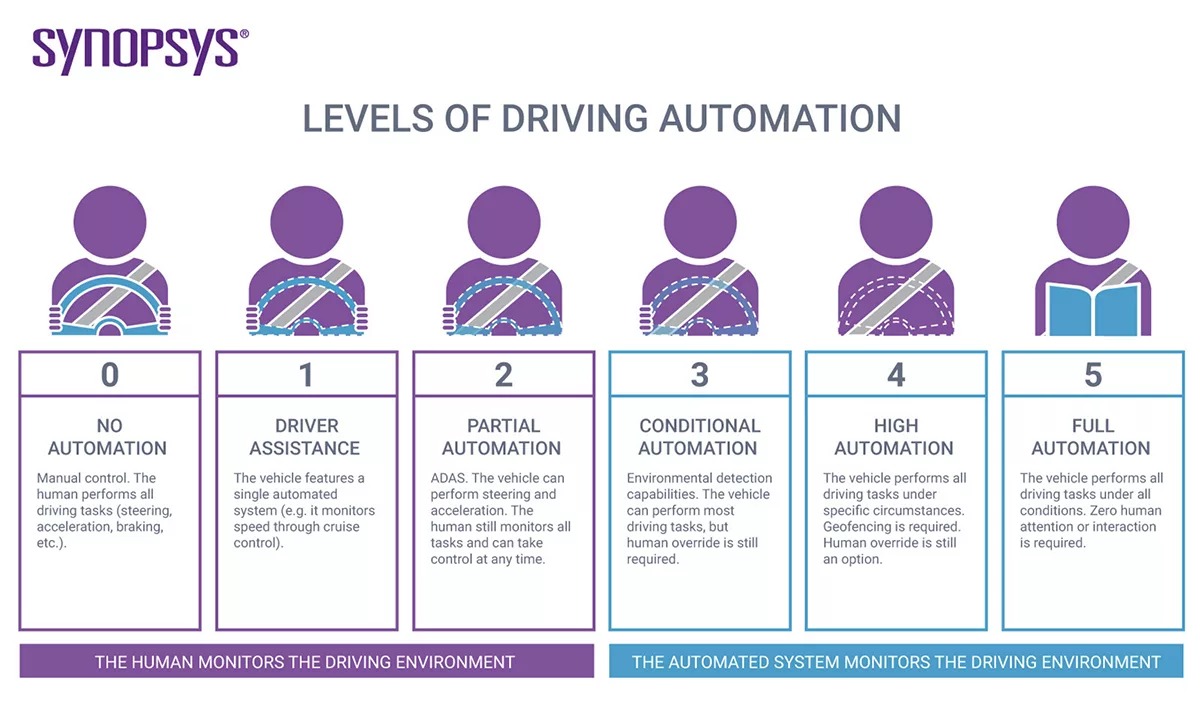
We divided the scenarios in perspectives of optimistic, realistic, pessimistic, and from 5 years, 10 years and 50 years.
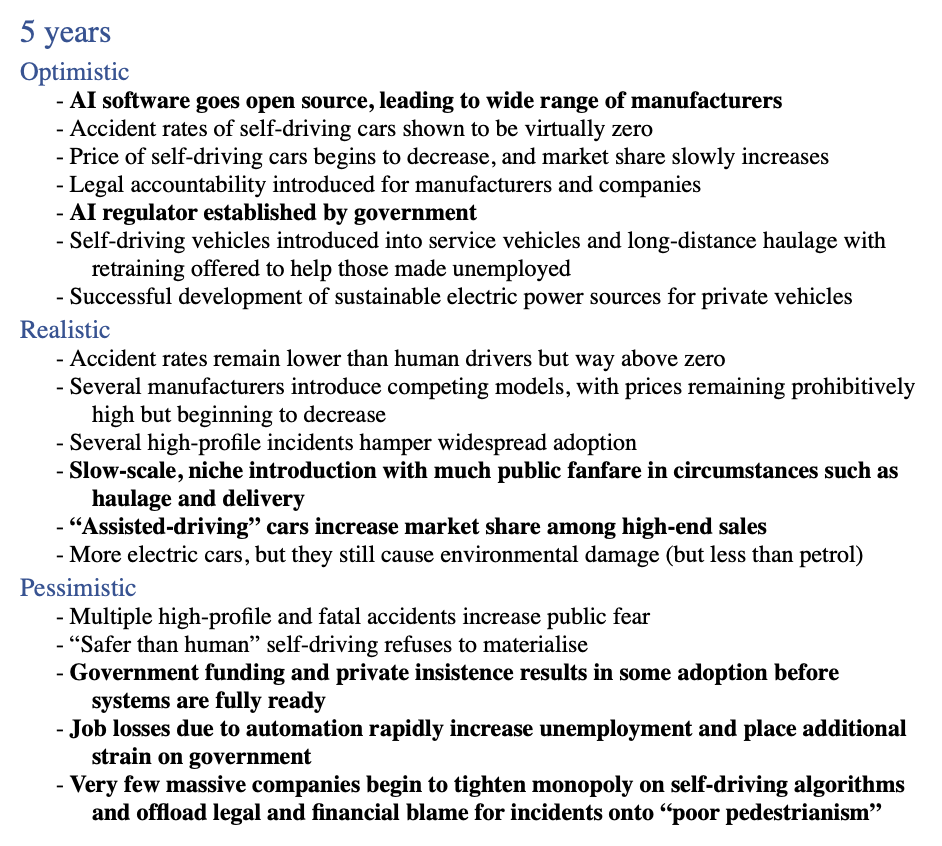



Collage & Bodystorming:

We used the real world news/report/articles about risks of self-driving cars and tried to build a world in the near future about self-driving cars by visualizing them.

We also tried to do a self-driving Bodystorming research by having it in two stages according to the levels of automation.
Stage one:
- the volunteer has their eyes open, and is able to give instructions
- the person pushing the chair will navigate on their own but will listen and respond to instructions
Stage two:
- the volunteer closes their eyes and gives no instructions
- the person pushing the chair will navigate entirely on their own, trying not to crash into anything
Questions:
- How safe did you feel?
- What, specifically, made you feel safe or unsafe? What would you have liked to have available?
Research Analysis:
According to the collage, bodystorming and our imaginative future world, we summarized the main risks of the whole system of self-driving cars.
- Automation
- Unaccountability
- Inequality
- Awareness
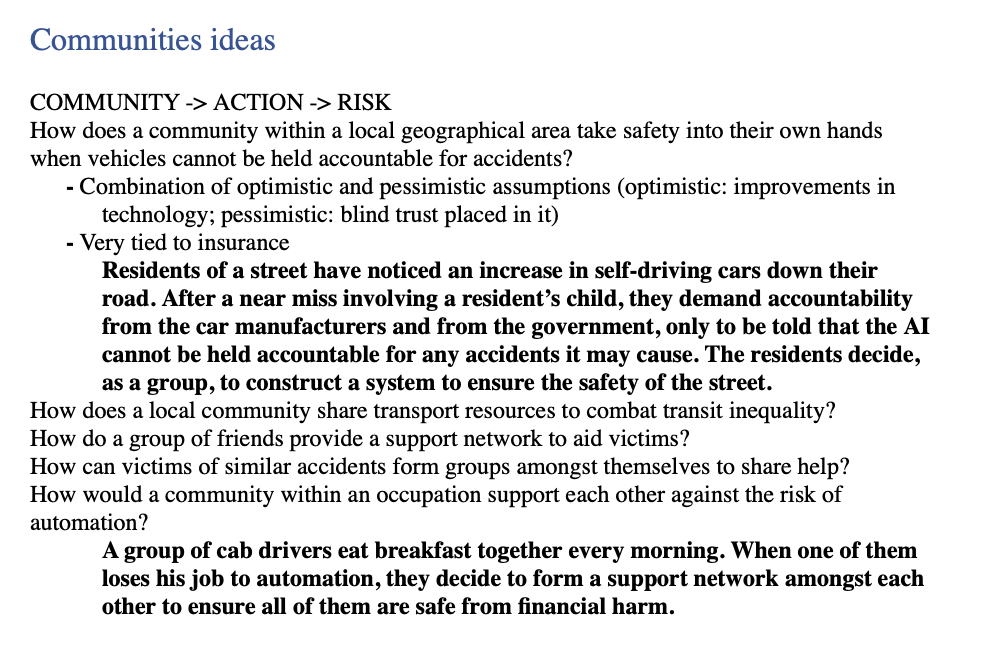
While we summarized the risks and thought about the future scenarios, we found that we still need to some research on the community. How would a community react to these risks and what kind of community it should be?
Presentation and feedback:

We talked about our nine stages of imaginative future scenarios and the research we did, collage and bodystorming. And then, the analysis key risks we found from the research. We also talked about our next steps on research is the community.

We got feedback saying we balanced well with expectations from AXA, brief and our interests. How we think about the infrastructure is good which matches our marco unit. From the perspective of presentation, we are suggested to think about how we can make the audience experience the world and scenery we built. As for later research, we need to make it real, talk to actual people and think about our design is from whose perspective. When building scenarios, we can think from the perspectives of social trend, behavior and technology. Research methods such as crazy eight, interviews also can help too.
Personal Reflection:
At this point, I start to think about if my understanding of the brief is a bit different than other people in my team. I thought we should be thinking what would a community do when a risk happen, such as questions asked in the brief, how can residents of a street manage the risk pf power cuts, fires, or falling into the sea through coastal erosion? What’s in my head was, design something for people after these situations happen, what they can do to help others. My team was thinking we should design something to prevent these risks happen, so think about all the potentials and design something for that. Actually, I was quite confused but what they said also makes sense. I got convinced by their explanations so we decide to go on the prevention design directions. What I learned from this is communication in a team is important, we can share our thoughts and end up have an agreement on specific point helps a lot on our design.
Week Three
According to the research we did from the last two week, we have a relatively clear and grounded context of our world of self-driving cars. For the next step, we want to come up with ideations and also think about how we want the audience to experience the world we built.
Crazy Eight:

We did the research method, crazy eight for idea generation. With the risks we researched in mind, we have two directions of the outcome:
- Blackbox - make data transparency for passengers about the self-driving bus and the information sharing in between them (risk of accountability)
- A community that creates minor accidents - for the people who have all the trust to the self-driving themselves, create minor accidents may help them be aware of the existence of risks (faulty sense of security, awareness)
At the same time, we want to build a situational narratives/persona by using the real life news, risks we found, all the settings we built. Think about the perspectives of:
-
Person - name, social status, job, lifestyle, medical conditions
- Place - a real place, details
- Situation - what happens, what are the activities
- Behaviour - what time do they take, what do they like, where are they going, why are they going, what do they see, smell…
- Social trends
- Cultural trends
- Technologies - what’s new?



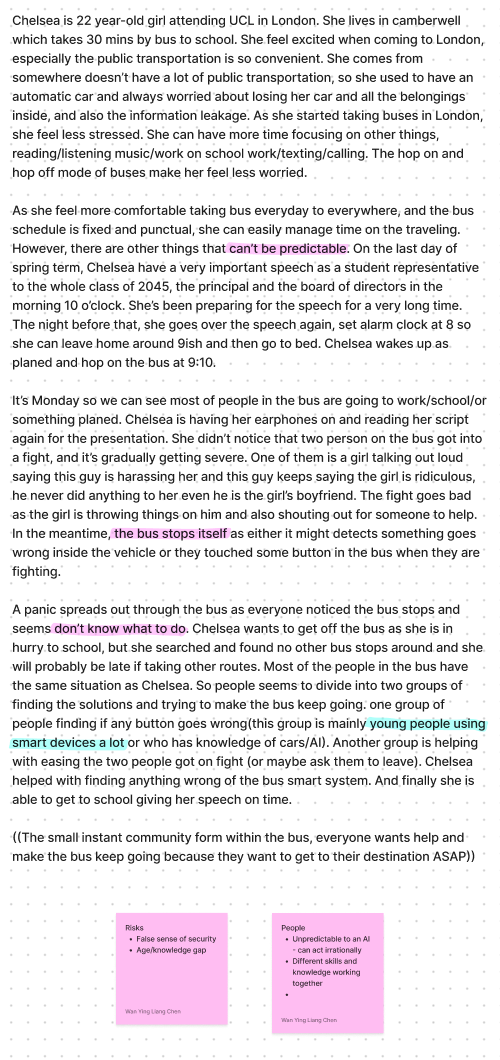




Anyasis and idea development:
After collecting each situational persona, we summarized the associated risks, what people mentioned, and how they reacted to the situation. We realized that the world of self-driving cars is complicated, with a wide range of potential issues that could arise. We can either build a community that responds instantly to each situation or work to improve self-driving car technology to prevent these risks from occurring in the first place.
When considering how to push further on the two research directions we had, we began to contemplate the best way to present them and in what form they should exist. For the blackbox idea, if we want the bus information to be clear to the riders, it has to be something they can hold while taking the bus. At this moment, we can't think of a better option than an app. We could also create a product with this function that people can carry with them everywhere, but we believe that would require a lot of time spent on product design rather than focusing on the functions and features that passengers can use.
Idea One:
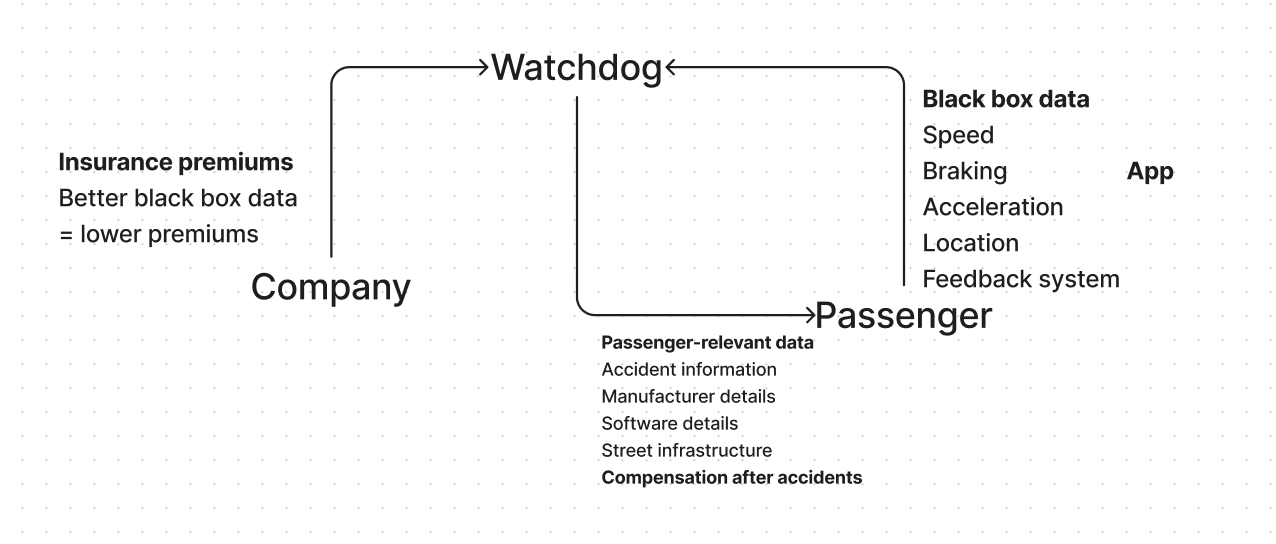
We thought about this app should be separate from the company made the bus, it should be from a third organisation. Also, we want to give these self-driving bus another name, we thought about OMNI bus which helps us identified.





Main pages of our first draft of the Blackbox.
Idea Two:
For our second idea, the community of creating minor accidents for self-driving bus, we thought about what kind of minor accidents should be put in use.
- Maybe push an empty pram in front of a self-driving bus, test if the bus can see it and what things people on the bus would do.
- Broadcast announcements get hacked and saying something threatening.
- Unrecognizable or confusing road signs.
For this community, we name it Accident Design Bureau, short for ADB. In terms of giving us more context and pictures about this community, we also created a logo according to what does it do.


And the announcement recordings on the bus we imagined:
Hacked broadcast:
Prepare for the mid-point presentation:









Mid-point presentation and feedback:

During the presentation, we present our two ideas, the app design and the ADB, as well as the example accident this community does. In terms of the settings in the presentation, we tried to demonstrate our ideas in scenarios and let people have a feeling of sitting in a self-driving bus.
We got feedback saying our presentation is good. The pamphlet is good and smart. In terms of research method, maybe we can go on a bus, AEIOU, think about what’s available. How we present the idea is important, we can try present our ideas on bus. As for our design outcomes, we are suggested to think about how to make them in a physical form. We are also introduced two concept of design, boundary object and diegetic prototype.